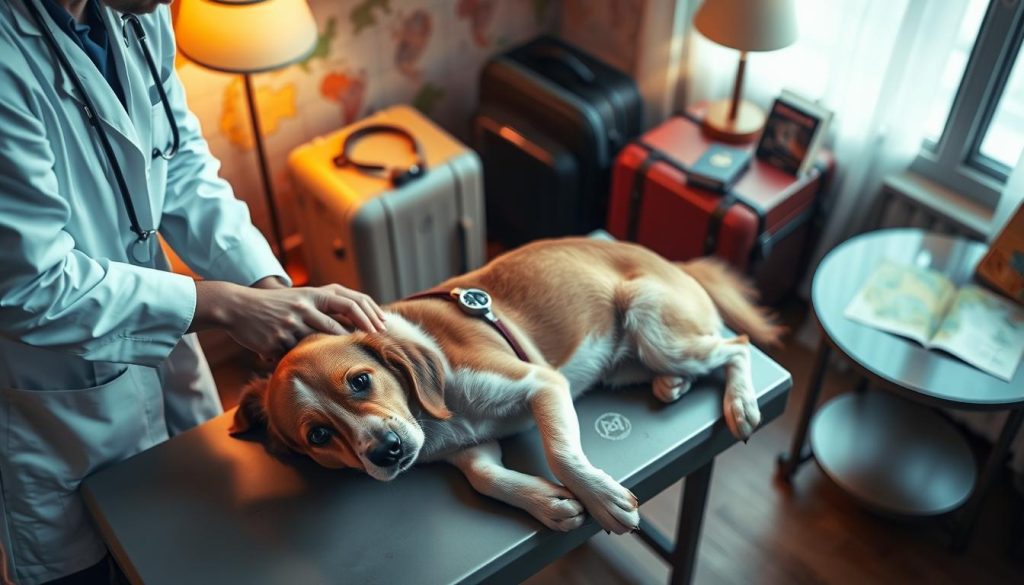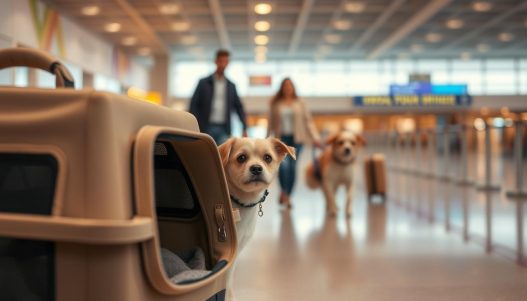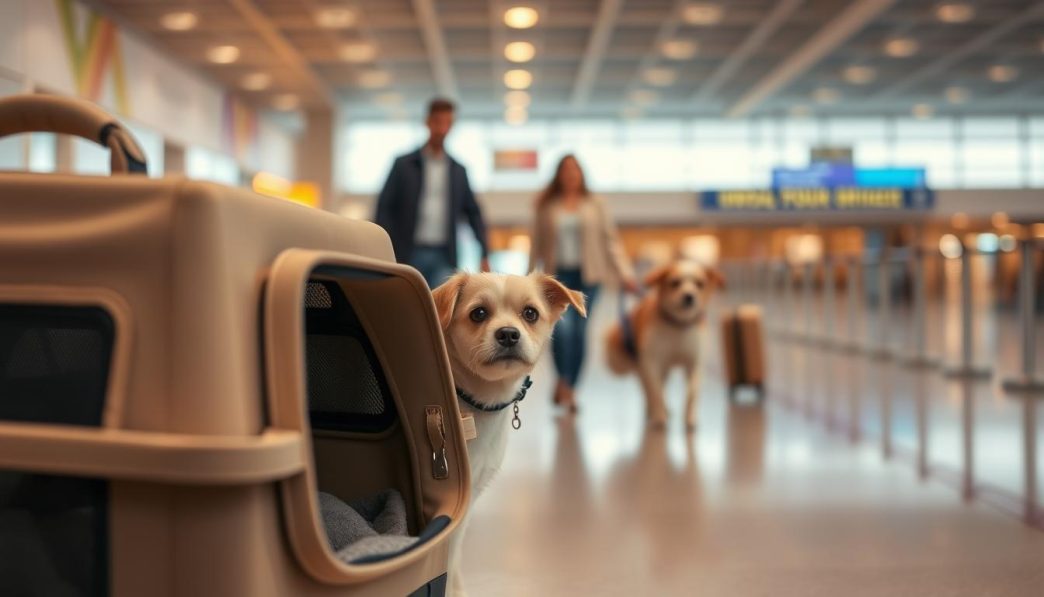Ensuring your pet’s health and safety while traveling is crucial. Whether you’re planning a short road trip or a long-distance journey, preparing your pet in advance is key to a stress-free experience.
Pet travel requires careful planning, including choosing the right transportation, packing essential supplies, and understanding the health requirements for your destination.
By focusing on pet safety and taking necessary precautions, you can help prevent health issues and ensure a smooth trip for both you and your pet.
Key Takeaways
- Plan ahead for your pet’s travel needs.
- Choose the right transportation for your pet.
- Pack essential supplies for your pet’s health and comfort.
- Research health requirements for your destination.
- Prepare for emergencies with a pet first-aid kit.
Planning Your Pet’s Journey: Essential Pre-Travel Preparations
Before you embark on a journey with your pet, it’s essential to prepare them for the trip to ensure their health and safety. Proper planning can make a significant difference in your pet’s travel experience.
Veterinary Check-ups and Health Certificates
A visit to the veterinarian is a critical step in preparing your pet for travel. Veterinary check-ups help identify any health issues that could impact your pet’s ability to travel safely.
Required Documentation for Interstate and International Travel
Depending on your destination, you may need to obtain a health certificate for your pet. This document certifies that your pet is healthy enough for travel and complies with the regulations of your destination.
Timeline for Pre-Travel Veterinary Visits
It’s recommended to schedule your pet’s veterinary visit at least 30 days prior to your trip to allow time for any necessary vaccinations or treatments.
Updating Vaccinations and Preventative Medications
Ensure your pet’s vaccinations are up-to-date, as required by your destination. Additionally, discuss preventative medications for parasites like fleas, ticks, and heartworms with your veterinarian.
Microchipping and ID Tags: Ensuring Your Pet Can Be Identified
Microchipping your pet provides a permanent form of identification. Ensure your pet’s ID tags are updated with your current contact information. This step is crucial in case your pet becomes lost during travel.
By following these essential pre-travel preparations, you can help ensure a safe and enjoyable journey for your pet.
Traveling with Pets: A Complete Health and Safety Guide for Different Transportation Methods
Whether you’re driving, flying, or taking the train, each transportation method has its own set of rules and safety considerations for pets. Ensuring your pet’s safety during travel requires careful planning and preparation, tailored to the specific mode of transportation you choose.
Road Trip Safety: Securing Your Pet in Vehicles
For many pet owners, road trips are a preferred way to travel with their pets. However, it’s crucial to secure your pet properly within the vehicle to prevent distractions while driving and to protect them in case of sudden stops or accidents.
Car Harnesses, Carriers, and Barriers
Using a car harness, carrier, or barrier can significantly enhance your pet’s safety during a road trip. A car harness attaches to your pet’s collar and to the vehicle’s seatbelt, keeping them restrained. Carriers provide a safe space for your pet, while barriers separate your pet from the front seats, reducing distractions.
Safe Driving Practices with Pets
Safe driving practices are essential when traveling with pets. Avoid letting your pet sit on your lap or roam freely in the vehicle. Keep your pet calm and comfortable to minimize distractions. Regular breaks during long trips can help reduce your pet’s stress and prevent discomfort.
Air Travel Regulations and Airline-Specific Requirements
Air travel with pets involves navigating complex regulations and airline-specific requirements. Understanding these rules is crucial for a smooth journey.
Cabin vs. Cargo Hold Considerations
Deciding whether your pet will travel in the cabin or cargo hold depends on their size, breed, and health. Smaller pets may travel in the cabin in approved carriers, while larger pets often travel in the cargo hold. Research the airline’s policies and consider your pet’s comfort and safety.
Airline-Approved Carriers
Using an airline-approved carrier is mandatory for air travel. These carriers are designed to meet the safety standards of airlines and provide your pet with a secure environment during the flight.
Train and Bus Travel: Policies and Restrictions
Train and bus travel offer alternative options for pet owners. However, policies regarding pets vary significantly between companies. Some allow pets in carriers, while others may not permit them at all.
Before booking, research the train or bus company’s pet policy to ensure a smooth journey. Understand any restrictions on pet size, breed, or required documentation.
Essential Pet Travel Gear and Supplies
To ensure a comfortable and enjoyable trip for both you and your pet, the right travel supplies are essential. Traveling with pets requires more than just a spontaneous decision to pack up and go; it demands careful planning and the right equipment to ensure their safety and comfort.
Selecting the Right Carrier or Crate
Choosing the appropriate carrier or crate is a critical decision when preparing for pet travel. The carrier must provide enough space for your pet to stand, turn around, and lie down comfortably.
Size and Ventilation Requirements
A carrier that is too small can cause discomfort, while one that is too large may not provide the necessary sense of security. Proper ventilation is crucial to prevent overheating and ensure a steady supply of fresh air. Look for carriers with adequate ventilation holes or mesh panels.
Comfort and Security Features
Comfort and security features are vital for reducing your pet’s stress during travel. Consider carriers with padded interiors, secure latches, and easy-to-clean surfaces.
Comfort Items: Bedding, Toys, and Familiar Objects
Bringing familiar items from home can provide comfort to your pet in new environments. Include their favorite bedding, toys, and other comforting objects to reduce anxiety.
“The comfort of familiar scents and objects can significantly reduce a pet’s travel stress.”
Food, Water, and Feeding Equipment for the Journey
Maintaining your pet’s regular feeding schedule is crucial during travel. Pack enough of their regular food and bring appropriate feeding equipment.
Portable Bowls and Water Dispensers
Portable bowls and water dispensers are convenient for feeding and hydrating your pet on the go. Look for collapsible or lightweight options.
Food Storage Solutions
Keep your pet’s food fresh with airtight storage containers. Consider portioning out meals in advance to simplify feeding during the journey.
| Equipment | Features to Consider |
|---|---|
| Pet Carrier/Crate | Size, ventilation, comfort, security |
| Portable Bowls | Collapsible, lightweight, easy to clean |
| Water Dispensers | Leak-proof, easy to refill |
| Food Storage | Airtight, portion control |
Managing Your Pet’s Health During Travel
Managing your pet’s health during travel involves several key considerations to keep them safe and comfortable. Traveling can be challenging for pets, and being prepared is crucial for a successful trip.
Motion Sickness: Prevention and Treatment
Motion sickness is a common issue for pets during travel. Preventative measures can be taken to minimize its effects. Keeping your pet in a well-ventilated area and ensuring they face the direction of travel can help.
Natural Remedies vs. Medications
There are various options available to treat motion sickness in pets, including natural remedies like ginger and medications prescribed by a veterinarian. It’s essential to consult with a vet before administering any treatment.
Anxiety and Stress: Recognizing and Reducing Travel-Related Tension
Traveling can cause significant anxiety and stress for pets. Recognizing the signs of travel stress is crucial for taking appropriate measures.
Behavioral Signs of Travel Stress
Common signs include pacing, panting, and restlessness. Observing your pet’s behavior can help identify if they are experiencing stress.
Calming Techniques and Products
Various calming products and techniques are available, such as pheromone diffusers, calming treats, and gentle exercise before travel. These can help reduce your pet’s travel-related tension.
Maintaining Regular Feeding and Medication Schedules
Maintaining your pet’s regular feeding and medication schedules is vital during travel. This helps prevent digestive upset and ensures your pet remains healthy.

By focusing on these key areas, you can help ensure your pet’s health and well-being during travel, making the journey enjoyable for both you and your pet.
Pet-Friendly Accommodations: What to Look For
For pet owners, the key to a successful trip lies in choosing accommodations that cater to their pets’ needs. With the rise in pet-friendly travel, numerous hotels and rental properties now welcome furry friends.
Researching and Booking Pet-Friendly Hotels and Rentals
When searching for a place to stay, it’s essential to filter your options to include only those that allow pets. Utilize online resources to streamline your search.
Online Resources for Finding Pet-Friendly Lodging
Websites like BringFido and PetFriendlyTravel.com offer comprehensive databases of pet-friendly hotels and vacation rentals. You can filter by location, pet type, and even pet size to find the perfect match.
Pet Fees, Deposits, and Accommodation Restrictions
Be aware that many pet-friendly accommodations come with additional fees or deposits. Understand these costs upfront to avoid surprises.
Creating a Safe Space for Your Pet in Temporary Lodging
Once you’ve booked your pet-friendly accommodation, prepare a safe space for your pet. Bring familiar items like their bed or favorite toys to make them feel at home.
Destination Considerations for Pet Travelers
Destination considerations play a significant role in ensuring your pet’s health and safety during travel. Different locations present unique challenges, from extreme climates to local hazards, that can impact your pet’s well-being.
Climate and Weather Factors: Protecting Your Pet from Extremes
Understanding the climate and weather conditions at your destination is crucial. Extreme temperatures, whether hot or cold, can pose significant risks to your pet’s health.
Hot Weather Precautions
In hot weather, it’s essential to protect your pet from heatstroke. Ensure your pet has access to plenty of water and shade, and avoid exercising them during the hottest parts of the day. Some breeds are more susceptible to heat, so extra precautions are necessary.
Cold Weather Gear and Considerations
In cold climates, pets need protection from frostbite and hypothermia. Consider using pet coats or sweaters, and limit their exposure to cold temperatures. Adjust their diet accordingly to maintain their energy levels.
Local Hazards: Wildlife, Plants, and Environmental Concerns
Local hazards such as wildlife, toxic plants, and environmental pollutants can pose significant threats to your pet. Researching these hazards in advance can help you take necessary precautions to keep your pet safe.
- Be aware of local wildlife that could be dangerous to your pet.
- Identify toxic plants and keep your pet away from them.
- Understand any local environmental concerns, such as pollution or contaminated water sources.
Finding Pet-Friendly Activities and Attractions
Ensuring that your destination offers pet-friendly activities and attractions can enhance your travel experience. Research parks, beaches, and other venues that welcome pets.
Some popular pet-friendly activities include:
- Hiking in pet-friendly trails.
- Visiting dog parks or beaches.
- Exploring pet-friendly cities with outdoor dining and shopping areas.

Emergency Preparedness for Pet Travel
Emergency preparedness is a vital aspect of pet travel that can make a significant difference in unexpected situations. Traveling with pets can be a wonderful experience, but it requires careful planning to ensure their safety and well-being.
Creating a Pet First Aid Kit
A pet first aid kit is an essential item when traveling with your pet. It should include supplies to treat minor injuries and prevent more serious conditions from developing.
Essential Medications and Supplies
Some of the key items to include in your pet first aid kit are bandages, antiseptic wipes, tweezers, and any medications your pet may need. It’s also a good idea to include a first aid guide specifically designed for pets.
- Bandages and bandage wraps
- Antiseptic wipes and sprays
- Tweezers and scissors
- Pet-specific medications
Locating Veterinary Services at Your Destination
Before arriving at your destination, it’s crucial to identify local veterinary services. Research online or contact your local vet for recommendations on veterinary clinics or hospitals near your destination.
Having the contact information of a local vet can be invaluable in case of an emergency.
What to Do If Your Pet Gets Lost While Traveling
If your pet gets lost while traveling, it’s essential to act quickly. Keep a recent photo of your pet and have a plan in place for how to search for them.
Digital and Physical Resources for Finding Lost Pets
Utilize social media, local lost pet listings, and pet-friendly establishments to spread the word. Consider using a GPS tracking device on your pet’s collar to help locate them if they become lost.
“The best way to prevent your pet from getting lost is to be prepared and keep a close eye on them at all times.”
Special Considerations for Different Types of Pets
Traveling with pets requires understanding their unique requirements. Different pets have varying needs when it comes to travel, and being aware of these needs is crucial for a safe and enjoyable journey.
Dogs: Breed-Specific Travel Concerns
Some dog breeds are more suited to travel than others. For instance, brachycephalic breeds face specific risks due to their anatomy.
Brachycephalic Breeds and Travel Risks
Brachycephalic breeds, such as Pugs and Bulldogs, can experience respiratory distress, especially in hot or stressful conditions. It’s essential to take extra precautions when traveling with these breeds, such as avoiding air travel and keeping them cool.
Cats: Reducing Stress for Feline Travelers
Cats are known for their sensitivity to stress, and travel can be particularly challenging for them. To minimize stress, it’s recommended to keep their carrier in a quiet, comfortable spot and provide familiar items like blankets or toys.
Small Pets, Birds, and Exotic Animals: Unique Travel Requirements
Small pets, including birds and exotic animals, have specific travel needs. For example, birds require large, well-ventilated carriers to prevent stress and injury. Exotic animals may have particular temperature and humidity requirements that must be met during travel.
| Pet Type | Special Considerations |
|---|---|
| Dogs (Brachycephalic Breeds) | Avoid air travel, keep cool |
| Cats | Minimize stress with familiar items |
| Birds | Large, well-ventilated carriers |
| Exotic Animals | Specific temperature and humidity needs |
Conclusion: Ensuring Safe and Enjoyable Travel Experiences with Your Pet
Traveling with pets can be a wonderful experience, but it requires careful planning and preparation to ensure a safe and enjoyable journey for both you and your pet. By following the guidelines and pet travel tips outlined in this comprehensive guide, you can minimize risks and create lasting memories with your furry companion.
From pre-travel preparations to destination considerations, we’ve covered the essential aspects of pet travel. Whether you’re embarking on a road trip or flying to your destination, prioritizing your pet’s health and safety is crucial for a stress-free journey. By choosing pet-friendly accommodations and being prepared for emergencies, you can ensure a safe travel experience for your pet.
As you plan your next adventure with your pet, remember to stay informed about local hazards, keep your pet’s identification up to date, and pack essential supplies. With careful planning and attention to detail, you can create an enjoyable travel experience for your pet, making your journey together a success.






